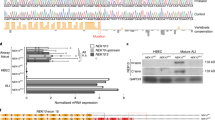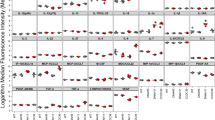Abstract
Primary ciliary dyskinesia (PCD) is a genetically heterogenous autosomal recessive disease in which mutations disrupt ciliary function, leading to impaired mucociliary clearance and life-long lung disease. Mouse tracheal cells with a targeted deletion in the axonemal dynein intermediate chain 1 (Dnaic1) gene differentiate normally in culture but lack ciliary activity. Gene transfer to undifferentiated cultures of mouse Dnaic1−/− cells with a lentiviral vector pseudotyped with avian influenza hemagglutinin restored Dnaic1 expression and ciliary activity. Importantly, apical treatment of well-differentiated cultures of mouse Dnaic1−/− cells with lentiviral vector also restored ciliary activity, demonstrating successful gene transfer from the apical surface. Treatment of Dnaic1flox/flox mice expressing an estrogen-responsive Cre recombinase with different doses of tamoxifen indicated that restoration of ∼20% of ciliary activity may be sufficient to prevent the development of rhinosinusitis. However, although administration of a β-galactosidase-expressing vector into control mice demonstrated efficient gene transfer to the nasal epithelium, treatment of Dnaic1−/− mice resulted in a low level of gene transfer, demonstrating that the severe rhinitis present in these animals impedes gene transfer. The results demonstrate that gene replacement therapy may be a viable treatment option for PCD, but further improvements in the efficiency of gene transfer are necessary.
This is a preview of subscription content, access via your institution
Access options
Subscribe to this journal
Receive 12 print issues and online access
$259.00 per year
only $21.58 per issue
Buy this article
- Purchase on Springer Link
- Instant access to full article PDF
Prices may be subject to local taxes which are calculated during checkout







Similar content being viewed by others
References
Bush A, Chodhari R, Collins N, Copeland F, Hall P, Harcourt J et al. Primary ciliary dyskinesia: current state of the art. Arch Dis Child 2007; 92: 1136–1140.
Leigh MW, Pittman JE, Carson JL, Ferkol TW, Dell SD, Davis SD et al. Clinical and genetic aspects of primary ciliary dyskinesia/Kartagener syndrome. Genet Med 2009; 11: 473–487.
Kennedy MP, Omran H, Leigh MW, Dell S, Morgan L, Molina PL et al. Congenital heart disease and other heterotaxic defects in a large cohort of patients with primary ciliary dyskinesia. Circulation 2007; 115: 2814–2821.
Nakhleh N, Francis R, Giese RA, Tian X, Li Y, Zariwala MA et al. High prevalence of respiratory ciliary dysfunction in congenital heart disease patients with heterotaxy. Circulation 2012; 125: 2232–2242.
Knowles MR, Daniels LA, Davis SD, Zariwala MA, Leigh MW . Primary ciliary dyskinesia. Recent advances in diagnostics, genetics, and characterization of clinical disease. Am J Respir Crit Care Med 2013; 188: 913–922.
Stillwell PC, Wartchow EP, Sagel SD . Primary ciliary dyskinesia in children: a review for pediatricians, allergists, and pediatric pulmonologists. Pediatr Allergy Immunol Pulmonol 2011; 24: 191–196.
Zariwala MA, Omran H, Ferkol TW . The emerging genetics of primary ciliary dyskinesia. Proc Am Thorac Soc 2011; 8: 430–433.
Griesenbach U, Alton EW . Cystic fibrosis gene therapy: successes, failures and hopes for the future. Expert Rev Respir Med 2009; 3: 363–371.
Parsons DW . Airway gene therapy and cystic fibrosis. J Paediatr Child Health 2005; 41: 94–96.
Pickles RJ . Physical and biological barriers to viral vector-mediated delivery of genes to the airway epithelium. Proc Am Thorac Soc 2004; 1: 302–308.
Buckley SM, Howe SJ, Sheard V, Ward NJ, Coutelle C, Thrasher AJ et al. Lentiviral transduction of the murine lung provides efficient pseudotype and developmental stage-dependent cell-specific transgene expression. Gene Ther 2008; 15: 1167–1175.
Medina MF, Kobinger GP, Rux J, Gasmi M, Looney DJ, Bates P et al. Lentiviral vectors pseudotyped with minimal filovirus envelopes increased gene transfer in murine lung. Mol Ther 2003; 8: 777–789.
Mitomo K, Griesenbach U, Inoue M, Somerton L, Meng C, Akiba E et al. Toward gene therapy for cystic fibrosis using a lentivirus pseudotyped with Sendai virus envelopes. Mol Ther 2010; 18: 1173–1182.
Sinn PL, Burnight ER, Hickey MA, Blissard GW, McCray PB Jr . Persistent gene expression in mouse nasal epithelia following feline immunodeficiency virus-based vector gene transfer. J Virol 2005; 79: 12818–12827.
McKay T, Patel M, Pickles RJ, Johnson LG, Olsen JC . Influenza M2 envelope protein augments avian influenza hemagglutinin pseudotyping of lentiviral vectors. Gene Ther 2006; 13: 715–724.
Patel M, Giddings AM, Sechelski J, Olsen JC . High efficiency gene transfer to airways of mice using influenza hemagglutinin pseudotyped lentiviral vectors. J Gene Med 2013; 15: 51–62.
Stocker AG, Kremer KL, Koldej R, Miller DS, Anson DS, Parsons DW . Single-dose lentiviral gene transfer for lifetime airway gene expression. J Gene Med 2009; 11: 861–867.
Ostrowski LE, Yin W, Rogers TD, Busalacchi KB, Chua M, O'Neal WK et al. Conditional deletion of dnaic1 in a murine model of primary ciliary dyskinesia causes chronic rhinosinusitis. Am J Respir Cell Mol Biol 2010; 43: 55–63.
Guichard C, Harricane MC, Lafitte JJ, Godard P, Zaegel M, Tack V et al. Axonemal dynein intermediate-chain gene (DNAI1) mutations result in situs inversus and primary ciliary dyskinesia (Kartagener syndrome). Am J Hum Genet 2001; 68: 1030–1035.
Pennarun G, Escudier E, Chapelin C, Bridoux AM, Cacheux V, Roger G et al. Loss-of-function mutations in a human gene related to Chlamydomonas reinhardtii dynein IC78 result in primary ciliary dyskinesia. Am J Hum Genet 1999; 65: 1508–1519.
Zariwala M, Noone PG, Sannuti A, Minnix S, Zhou Z, Leigh MW et al. Germline mutations in an intermediate chain dynein cause primary ciliary dyskinesia. Am J Respir Cell Mol Biol 2001; 25: 577–583.
Zariwala MA, Leigh MW, Ceppa F, Kennedy MP, Noone PG, Carson JL et al. Mutations of DNAI1 in primary ciliary dyskinesia: evidence of founder effect in a common mutation. Am J Respir Crit Care Med 2006; 174: 858–866.
Wilkerson CG, King SM, Koutoulis A, Pazour GJ, Witman GB . The 78 000 M(r) intermediate chain of Chlamydomonas outer arm dynein is a WD-repeat protein required for arm assembly. J Cell Biol 1995; 129: 169–178.
Lee L . Riding the wave of ependymal cilia: Genetic susceptibility to hydrocephalus in primary ciliary dyskinesia. J Neurosci Res 2013; 91: 1117–1132.
Vogel P, Read RW, Hansen GM, Payne BJ, Small D, Sands AT et al. Congenital hydrocephalus in genetically engineered mice. Vet Pathol 2012; 49: 166–181.
Francis RJ, Christopher A, Devine WA, Ostrowski L, Lo C . Congenital heart disease and the specification of left-right asymmetry. Am J Physiol Heart Circ Physiol 2012; 302: H2102–H2111.
Tan SY, Rosenthal J, Zhao XQ, Francis RJ, Chatterjee B, Sabol SL et al. Heterotaxy and complex structural heart defects in a mutant mouse model of primary ciliary dyskinesia. J Clin Invest 2007; 117: 3742–3752.
Chhin B, Negre D, Merrot O, Pham J, Tourneur Y, Ressnikoff D et al. Ciliary beating recovery in deficient human airway epithelial cells after lentivirus ex vivo gene therapy. PLoS Genet 2009; 5: e1000422.
Lefebvre PA, Nordstrom SA, Moulder JE, Rosenbaum JL . Flagellar elongation and shortening in Chlamydomonas. IV. Effects of flagellar detachment, regeneration, and resorption on the induction of flagellar protein synthesis. J Cell Biol 1978; 78: 8–27.
David AL, Peebles D . Gene therapy for the fetus: is there a future? Best Pract Res Clin Obstet Gynaecol 2008; 22: 203–218.
Johnson LG, Mewshaw JP, Ni H, Friedmann T, Boucher RC, Olsen JC . Effect of host modification and age on airway epithelial gene transfer mediated by a murine leukemia virus-derived vector. J Virol 1998; 72: 8861–8872.
Ostrowski LE, Blackburn K, Radde KM, Moyer MB, Schlatzer DM, Moseley A et al. A proteomic analysis of human cilia: identification of novel components. Mol Cell Proteomics 2002; 1: 451–465.
You Y, Richer EJ, Huang T, Brody SL . Growth and differentiation of mouse tracheal epithelial cells: selection of a proliferative population. Am J Physiol Lung Cell Mol Physiol 2002; 283: L1315–L1321.
Sisson JH, Stoner JA, Ammons BA, Wyatt TA . All-digital image capture and whole-field analysis of ciliary beat frequency. J Microsc 2003; 211 (Pt 2): 103–111.
Buckley SM, Howe SJ, Rahim AA, Buning H, McIntosh J, Wong SP et al. Luciferin detection after intranasal vector delivery is improved by intranasal rather than intraperitoneal luciferin administration. Hum Gene Ther 2008; 19: 1050–1056.
Mery S, Gross EA, Joyner DR, Godo M, Morgan KT . Nasal diagrams: a tool for recording the distribution of nasal lesions in rats and mice. Toxicol Pathol 1994; 22: 353–372.
Acknowledgements
We thank Dr P Sears for technical assistance with the recording and analysis of ciliary activity for this project. This research was funded by NIH Grant 1RC1HL10081 to LEO and core grants NIH P30 DK065988, R026-CR11 from the Cystic Fibrosis Foundation, and IDG #2008-IDG-1017 from the NC Biotechnology Center. Research support was also provided by Oxford BioMedica to JCO.
Author information
Authors and Affiliations
Corresponding author
Ethics declarations
Competing interests
Dr JCO is a named inventor on patents involving equine infectious anemia virus (EIAV)-based gene transfer technology and has received royalties for the use of EIAV-based vectors. The remaining authors declare no conflict of interest.
Additional information
Supplementary Information accompanies this paper on Gene Therapy website
Rights and permissions
About this article
Cite this article
Ostrowski, L., Yin, W., Patel, M. et al. Restoring ciliary function to differentiated primary ciliary dyskinesia cells with a lentiviral vector. Gene Ther 21, 253–261 (2014). https://doi.org/10.1038/gt.2013.79
Received:
Revised:
Accepted:
Published:
Issue Date:
DOI: https://doi.org/10.1038/gt.2013.79
Keywords
This article is cited by
-
Genetic Spectrum and Clinical Characteristics of Patients with Primary Ciliary Dyskinesia: a Belgian Single Center Study
Lung (2024)
-
Primary Ciliary Dyskinesia: Integrating Genetics into Clinical Practice
Current Pulmonology Reports (2024)
-
Motile cilia genetics and cell biology: big results from little mice
Cellular and Molecular Life Sciences (2021)
-
Motile ciliopathies
Nature Reviews Disease Primers (2020)
-
Therapeutic perspectives for structural and functional abnormalities of cilia
Cellular and Molecular Life Sciences (2019)



